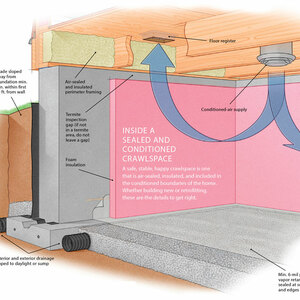This is driving me (and my wife) crazy. We keep having light bulbs burning out in our home, all too frequenly. House was built in 1941. K&T wiring for light fixtures in bedrooms, living room and dining room, as well as the receptacles in those rooms. These run off fuses in an old fuse box tied to the panel.
Kitchen and bath have been remodeled, and are on breakers, as is the soon to be finished lower level family room.
The panel was updated about 7 years ago. It’s a Siemens 100 AMP with 30 breaker slots. Permitted, and passed inspection. (Local inspector, that’s another story).
Garage has a 60 AMP subpanel tied to the main panel.
The bulbs that are burning out are all over the home, whether they’re on fuses or breakers, it doesn’t matter. There is no surge suppression on the main panel. Service to the home is overhead from the pole.
I know I’ve put a lot on this post. Hoping someone has an answer. Next step is a real good electrician. Thank you all in advance for your help. I respect all the pros and their opinions who frequent here.


















Replies
Bouncy floors did mine in, then I went CFL. No more burn outs.
Spheramid Enterprises Architectural Woodworks
Repairs, Remodeling, Restorations
They kill Prophets, for Profits.
The most common causes are vibration, overheating, and high voltage.
The overheating can be using the wrong style or too high of wattage in a fixture specially a recessed can.
But it can also be caused by bad socket in the fixture.
But since this is all over the house my guess is high voltage.
It can be either that the power company is supplying too high voltage or you have a bad neutral connection.
If you have a problem with light flickering call the power company.
They probably won't do anything with "high voltage" unless you have a meter and check it. Or get an electrician to check it.
William the Geezer, the sequel to Billy the Kid - Shoe
Bill,
Thank you for the response. I am adamant with my wife about not overwatting the fixtures. All the lighting fixtures are newer, as we have done extensive remodeling, so I don't think it's a fixture problem.
Question, if the voltage is too high, what is the fix on the electric company's end?
They can change a tap on the transformer..
William the Geezer, the sequel to Billy the Kid - Shoe
I had the same problem about 6 years ago, bulbs seemed to be short lived.Clothes dryer quit working also, bought a new one, would not work. Checked the line voltage and it was about 130.
Called GA power immediately (saturday afternoon). They said it was an emergency and sent someone out and replaced the transformer. I sent GA power an itemized list including a few new lamps, bulbs, a dryer, etc plus 15% of the last 3 months electric bills-- a bit over $1000.
They paid it, and my neighbors claims, with no questions.
Maybe you are using halogen fixtures? If so, when changing you CANNOT touch the lamp w/ your fingers ... sure guarantee to shorten their life. It says it on the package albeit in small print ... relatively speaking.
The reasons for burnouts are:
-- vibration
-- poor socket contact
-- excessive voltage
-- "perceived" problem
A "perceived" problem is not too unusual with a new homeowner, where all lots of lights are on all the time, and there are several a month that burn out. This is just the number of bulbs divided into the lifetime of a bulb -- you'll have one burn out about that often.
But we'll assume that this is a real vs perceived problem, and we'll also observe that having lights burn out in multiple locations eliminates vibration or poor socket contact. So that leaves excessive voltage.
Sometimes the voltage at the power pole is just too high. When this is the case, sometimes you can convince the power company to lower the voltage. If not, then you can use special 125V or 130V light bulbs.
But more common is a problem where the neutral connection between the breaker panel and the power pole has a bad connection. This can cause fluctuating voltage on circuits in the house, and, because house power is "balanced" with two 120V legs adding up to 240V, without the neutral the legs can become unbalanced such that one leg has a lower voltage and the other has a correspondingly higher voltage.
This situation of an open neutral can be very hazardous -- it creates a significant fire hazard and hazard to electrical devices in the house, and it can (in odd cases) contribute to a shock hazard. So the possibility of this is something to take seriously.
If you have a decent voltmeter and know a little about how to use it, the thing to do is to measure the voltage at 10 or so different places in the house. The voltage everywhere should agree within 2-3 volts. If you see much more variation than that an open neutral would be suspected and an electrician should be called.
If you're a bit more handy, you can measure the voltage between each leg and neutral in the main panel (or better, outside in the disconnect box, if you have one). If you see the same sort of significant difference between legs there then the power company should be called.
Here's a clue. When the power company came out to hook up the underground service this fall the employee took out his meter and checked the voltage at the panel. "Yep, that's good he said" when the meter showed 123.5V per leg. My son who works in the movie industry as a genny op commented that that was the voltage he always supplied to the rest of the crew. If your not using CFL's at least get 130V rated lamps.
I had the electric company send out a mete they left for a week . They never admitted to a problem, but burn out is now a thing of the past, imagine that!